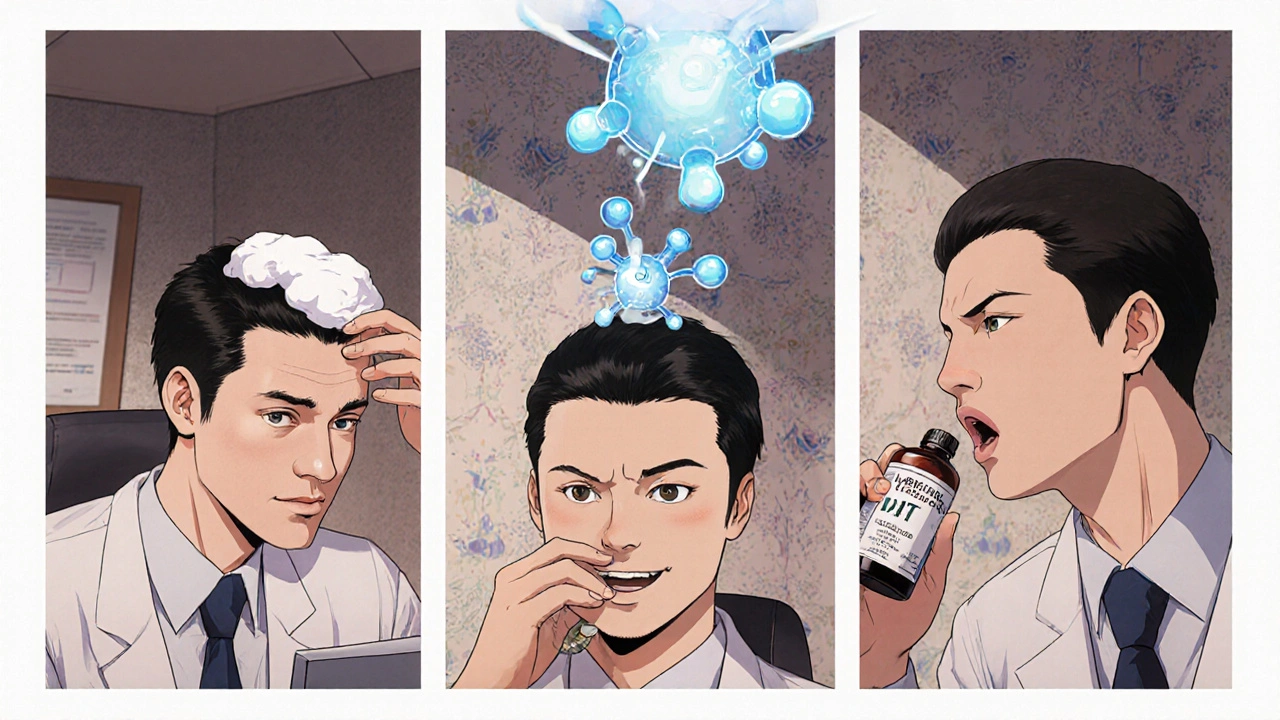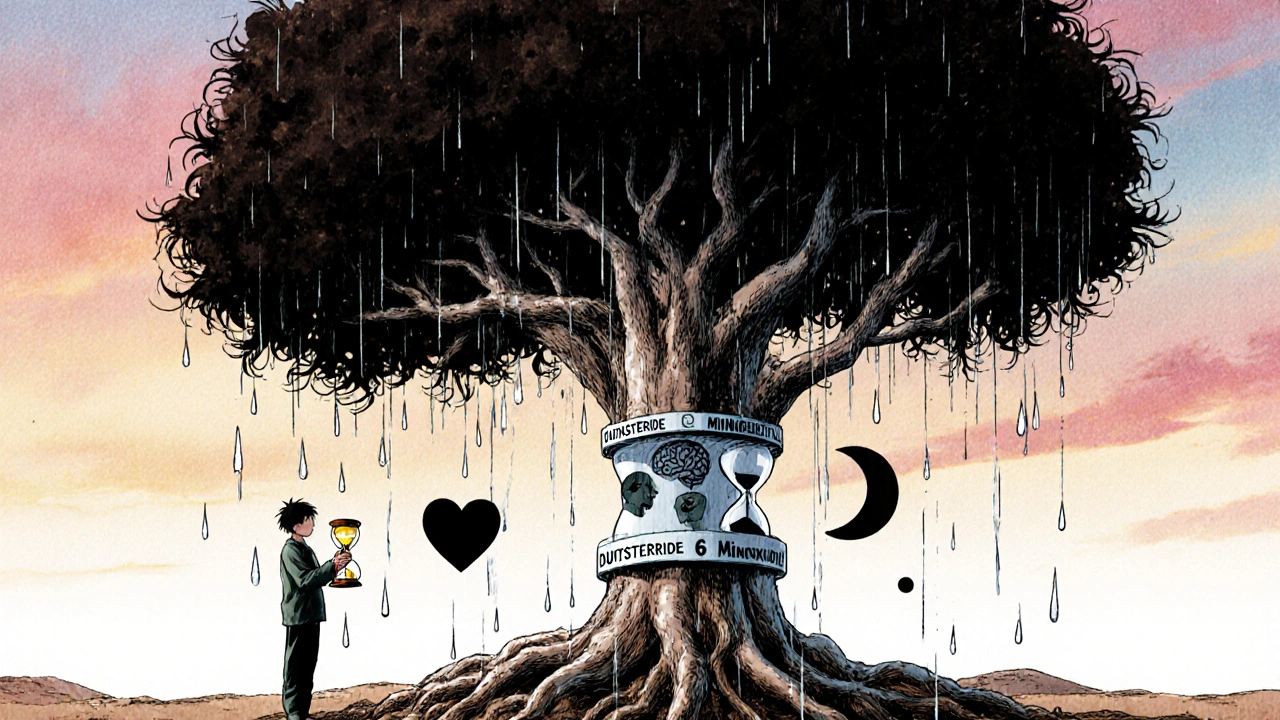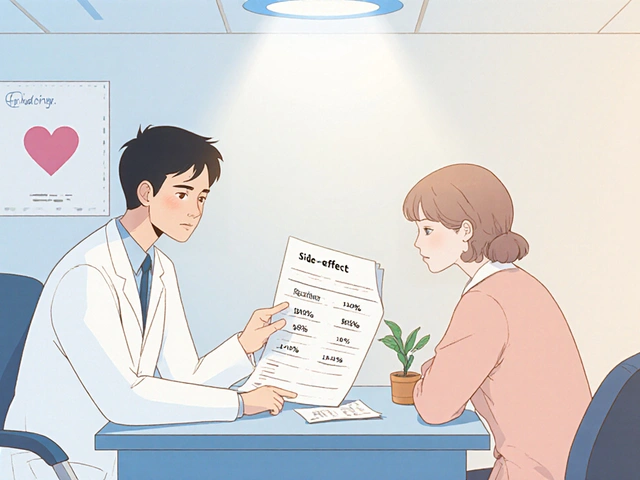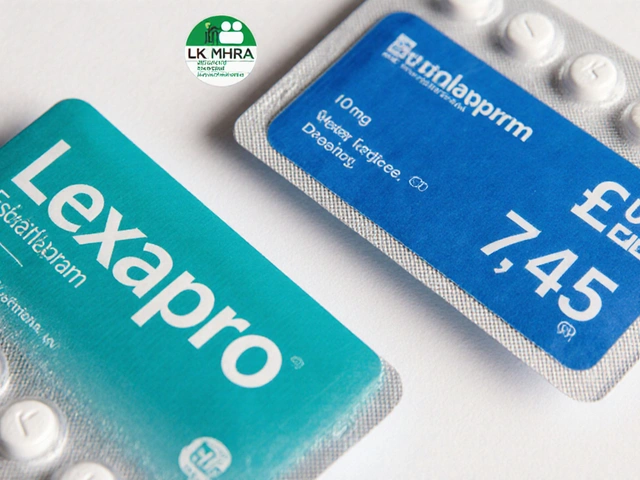When you’re dealing with hair loss or an enlarged prostate, finding the right treatment isn’t just about what works-it’s about what works for you. Dutas, the brand name for dutasteride, is a common choice. But it’s not the only option. Many people start with Dutas, then wonder: are there better, safer, or cheaper alternatives? The answer isn’t simple, but it’s clear once you know the facts.
What is Dutas (Dutasteride) and how does it work?
Dutasteride is a 5-alpha reductase inhibitor. That’s a fancy way of saying it blocks two types of enzymes-Type I and Type II-that turn testosterone into dihydrotestosterone (DHT). DHT is the hormone that shrinks hair follicles in men with genetic hair loss and causes the prostate to swell in benign prostatic hyperplasia (BPH).
Dutas is usually taken as a 0.5 mg capsule once a day. It’s FDA-approved for BPH and used off-label for male pattern baldness. Unlike finasteride, which only blocks Type II, dutasteride shuts down both pathways. That’s why some doctors say it’s more powerful-at least on paper.
But power doesn’t always mean better. In real life, side effects, cost, and long-term tolerance matter more than lab numbers.
Finasteride: The most common alternative
Finasteride (sold as Propecia or Proscar) is the go-to alternative to Dutas. It only blocks Type II 5-alpha reductase, so it doesn’t reduce DHT as much as dutasteride. Studies show finasteride lowers DHT by about 70%, while dutasteride knocks it down by 90%.
But here’s the twist: that extra 20% doesn’t always translate to better results for hair loss. A 2021 study in the Journal of the American Academy of Dermatology found no significant difference in hair regrowth between men taking 0.5 mg dutasteride and 1 mg finasteride after two years. Both groups saw similar improvements in hair density and thickness.
Finasteride wins on side effects. Men on finasteride report sexual side effects (like lower libido or erectile dysfunction) in about 3-5% of cases. For dutasteride, that number jumps to 6-8%. It’s not a huge difference, but for someone already anxious about losing their sex drive, every percentage point counts.
Cost is another factor. Generic finasteride costs as little as £10 a month in the UK. Generic dutasteride? Around £25. That’s not a dealbreaker for everyone, but if you’re paying out of pocket, the math matters.
Minoxidil: The topical option
If you want to avoid pills entirely, minoxidil (Rogaine) is the only FDA-approved topical treatment for male hair loss. It doesn’t touch DHT. Instead, it opens potassium channels in hair follicles, which may extend the growth phase of hair.
It’s applied twice daily as a liquid or foam. Results take 4-6 months. If you stop using it, you lose the gains within 3-6 months. That’s a big downside-lifelong commitment.
But minoxidil has one huge advantage: it doesn’t affect hormones. No sexual side effects. No risk of depression or brain fog (which some men report with DHT blockers). It’s also safe to use with finasteride or dutasteride. Many men combine all three: pills for the root cause, topicals for surface results.
It’s not a replacement for Dutas if you’re treating BPH. Minoxidil does nothing for the prostate. But for hair loss alone, it’s a solid, low-risk option.

Other alternatives: Natural and emerging options
Some men turn to supplements like saw palmetto, pumpkin seed oil, or beta-sitosterol. Saw palmetto has been studied for decades. A 2012 trial in Phytotherapy Research found it reduced DHT slightly and improved urinary symptoms in men with mild BPH-but it wasn’t as effective as finasteride.
It’s not a direct replacement. Saw palmetto might help with early-stage symptoms, but if your prostate is significantly enlarged or your hair loss is advanced, it won’t cut it. And there’s no solid proof it helps with hair regrowth in men.
Newer options like topical dutasteride or low-dose oral minoxidil are being explored. Topical dutasteride, applied directly to the scalp, may reduce systemic absorption and lower side effect risk. Early trials show promising results, but it’s not yet approved in the UK or US. You can get it from compounding pharmacies, but quality control varies.
Low-dose oral minoxidil (1-2.5 mg daily) is another emerging option. It’s not FDA-approved for hair loss, but dermatologists in the UK and US are prescribing it off-label. It works better than topical minoxidil for some men and has fewer scalp irritations. Side effects include mild fluid retention and increased body hair-but rarely sexual side effects.
Which one is right for you?
There’s no universal best. Your choice depends on your goals, budget, and tolerance for risk.
- If you have both BPH and hair loss, dutasteride is the most efficient single treatment.
- If you’re focused on hair loss only and want to minimize side effects, start with finasteride.
- If you’re afraid of pills or want zero hormonal impact, try minoxidil.
- If you’re on a tight budget, generic finasteride is the clear winner.
- If you’ve tried everything and still see no progress, talk to a dermatologist about low-dose oral minoxidil or topical dutasteride.
One thing’s certain: don’t switch treatments without medical advice. Stopping and starting these drugs can cause shedding or make results harder to predict. Give each option at least 6 months before deciding it’s not working.

What about side effects? The real risks
Everyone talks about sexual side effects-but they’re not the only concern. Some men report brain fog, depression, or persistent fatigue after stopping DHT blockers. This is called Post-Finasteride Syndrome (PFS), and while it’s rare, it’s real. There’s no cure, and it can last years.
Studies suggest PFS affects less than 1% of users, but the risk isn’t zero. That’s why many doctors recommend starting with the lowest effective dose. For hair loss, 0.25 mg of dutasteride or 0.5 mg of finasteride is often enough. You don’t need the full dose to see results.
Also, dutasteride stays in your system for months. If you stop and regret it, the drug doesn’t just leave your body quickly. That’s why some men choose finasteride instead-it clears faster.
Long-term safety: What the data says
Both dutasteride and finasteride have been used for over 20 years. Large studies, like those from the VA and the European Association of Urology, show they’re generally safe for long-term use. There’s a small increased risk of high-grade prostate cancer with both drugs-but that’s likely because they shrink the prostate, making cancer harder to detect, not because they cause it.
Regular prostate checks are still important. If you’re over 50 and on either drug, get your PSA levels monitored yearly. Your doctor can adjust for the drug’s effect on PSA levels (they typically lower it by 50%).
For hair loss, long-term use is even safer. Most men who stay on treatment for 5+ years maintain their results. The biggest reason people stop? Side effects. Not lack of effectiveness.
Final thoughts: No magic bullet, but plenty of options
Dutas isn’t the best choice for everyone. It’s powerful, yes-but it’s not always the smartest. Finasteride gives you nearly the same hair results with fewer side effects and lower cost. Minoxidil gives you a hormone-free path. Emerging treatments like low-dose oral minoxidil or topical dutasteride could change the game in the next few years.
What matters most isn’t which drug is strongest. It’s which one you can stick with. Hair loss and BPH are long-term conditions. You’re not just choosing a pill-you’re choosing a lifestyle.
Start simple. Talk to your GP or a dermatologist. Get blood work done. Know your DHT levels if possible. And don’t rush. The right treatment isn’t the one that works fastest-it’s the one you’ll still be taking in five years.
Is dutasteride better than finasteride for hair loss?
Dutasteride reduces DHT more than finasteride, but studies show both drugs produce nearly identical hair regrowth results after two years. Dutasteride has a slightly higher risk of sexual side effects and costs more. For most men, finasteride is the better starting point unless they also have moderate to severe BPH.
Can I take minoxidil with dutasteride?
Yes. Many men combine minoxidil with dutasteride or finasteride. Minoxidil works topically and doesn’t affect hormones, so it complements DHT blockers without increasing side effects. This combination is one of the most effective approaches for hair loss.
Does dutasteride cause permanent side effects?
In rare cases, some men report persistent sexual, mental, or physical side effects after stopping dutasteride, known as Post-Finasteride Syndrome. While the risk is low (under 1%), it’s real. If you experience unusual symptoms after stopping, consult a specialist. Starting with a lower dose can reduce this risk.
How long does it take for dutasteride to work for hair loss?
It typically takes 6-12 months to see noticeable results for hair loss. Some men notice reduced shedding after 3-4 months, but full regrowth takes longer. Patience is key-stopping early means you won’t know if it works.
Is there a natural alternative to dutasteride?
Saw palmetto and pumpkin seed oil may help with mild BPH symptoms and slightly reduce DHT, but they’re not as effective as prescription drugs. For significant hair loss or prostate enlargement, they’re not a replacement. They can be used as a supplement, but don’t expect dramatic results.








marie HUREL November 2, 2025
I started finasteride after reading this and honestly? My hair stopped falling out within 4 months. No drama, no side effects. I was scared at first, but it’s been 2 years now and I’m glad I stuck with it.
Leo Adi November 3, 2025
In India, we call finasteride ‘hair saver’-cheap, available over the counter, and works. Saw palmetto? Maybe for tea, not for real results. My uncle tried it for 6 months and still needed surgery for BPH. Don’t waste time.
Melania Rubio Moreno November 4, 2025
dutasteride is just finasteride but with more money and more drama. i tried it for 3 months and felt like my brain was wrapped in cotton. switched back. no regrets.
Gaurav Sharma November 5, 2025
It is statistically evident that dutasteride exhibits a 90% reduction in DHT levels, whereas finasteride achieves only 70%. The disparity in efficacy is not marginal-it is clinically significant. To recommend finasteride as a primary alternative is to prioritize cost over biological outcomes.
Shubham Semwal November 6, 2025
Bro, you’re all overthinking this. If you’re losing hair, take the pill. If you don’t want side effects, don’t take anything. Simple. Stop reading blogs and start taking action. Minoxidil? That’s for people who like sticky foam on their scalp every day.
Sam HardcastleJIV November 6, 2025
One cannot help but reflect upon the existential implications of pharmaceutical intervention in natural aging processes. Is the preservation of hair not, in essence, a denial of mortality? And yet, we reach for pills as if they were talismans against time.
Mira Adam November 7, 2025
Everyone’s so scared of side effects, but no one talks about how embarrassing it is to have a receding hairline at 30. If you’re not willing to risk a little libido loss to keep your confidence, then you’re not serious about your life.
Miriam Lohrum November 8, 2025
There’s something poetic about the fact that we’ve created drugs to fight the very biology that defines us. DHT isn’t evil-it’s just the system doing its job. Maybe the real question isn’t which drug to take, but whether we should be fighting this at all.
archana das November 9, 2025
My cousin in Delhi uses minoxidil + saw palmetto tea. He says his hair is thicker and he feels better. Not magic, but no pills either. If you’re scared of side effects, try natural first. No harm in trying.
Emma Dovener November 9, 2025
Topical dutasteride is the future. I’ve been using a compounded version for 8 months-no systemic side effects, and my hairline is filling in. Dermatologists in LA are prescribing it off-label all the time. Ask your doctor about compounding pharmacies.
Sue Haskett November 10, 2025
Just a quick note: if you’re thinking about switching from finasteride to dutasteride, please-please-talk to your doctor first. And if you’re considering low-dose oral minoxidil? Make sure you’re under supervision. These aren’t vitamins. They’re powerful drugs. And if you start feeling off? Stop. And get help. Seriously. Your mental health matters more than your hairline.